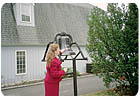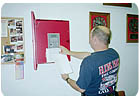The company has quite a history. It went big-time in 1913 with the purchase of the first motorized pump in the township. In 1920, a second fire truck was obtained, and the company has continued modernizing and expanding ever since.
The township has five fire companies in all. And the firehouse is a venerable landmark in the township, a three-story brick building built about 1890. The building is valuable, but even more important is the costly modern fire equipment housed there, and life safety aspects in the three-bedroom apartment on the building’s top story, which is rented out to firefighters. As building codes require, the apartment has its own local smoke and heat detectors, which are not connected to the rest of the building.

An intelligent integration strategy had to handle a historic site, expensive equipment and a harsh interior environment – all without false alarming, reported integrator Jodie Girsh, who is at the 1892 Elkins Park fire bell. Above right, the Elkins Park Firehouse was originally built in 1892.
Previous incident
A few years ago, a serious-sounding fire alarm originated in the firehouse. The siren started to go off, shorted out, sparked and came down and the first floor was filled with smoke.Firefighters on the premises quickly dealt with the problem, but it was clear that the heat detectors with which the working part of the station was fitted weren’t adequate to the need. A modern, smoke detector-based alarm system for the firehouse became a priority for the department and its directors.
A number of suppliers were asked to bid, but most were reluctant to participate. They felt that smoke detectors in the firehouse would frequently trip and false alarm because of heavy emissions from the massive diesel fire trucks housed, maintained and moving in and out of the garage. The building also featured a meeting hall where heavy smoking would take place, another questionable area in terms of false alarming.

Bill Obrecht (right), Elkins Park Fire Chief, and firehouse manager Tom Robinson at the Elkins Park Fire Department. The decision-makers overcame significant challenges in the life safety integration plan.
False alarm concerns
Girsh Alarm Co., an Elkins Park life safety and security company formed in 1977, was brought in as the only group willing to install and guarantee smoke detectors in the firehouse basement. A distributor of fire protection equipment made by Faraday, a component of Siemens Building Technologies Inc., Florham Park, N.J., Girsh Alarm was unconcerned about false alarms; according to owner/partners Jodie Girsh and Harry Girsh, the detector was guaranteed against it.Apart from its regular business with commercial, organizational and residential life safety, intrusion/security, surveillance and access control system alarms, Girsh does regular work in a number of firehouses in Cheltenham and its surrounding areas.
“We wanted to see if we could put smoke detectors in the garage bays where we would normally put thermal detectors,” said Harry Girsh. “Nobody thought you could have smoke detectors with the massive diesel fire trucks driving in and out. But Faraday’s detector is designed for use in garages.”

Elkins Park fire alarm panel features analog/addressable detectors and a unique neural network.
Neural advantages
A neural network enabled the detectors to perform with maximum efficiency in a parking and service garage environment, where conditions include airborne dust, a high level of diesel fumes and possible cigarette smoke. After installation, the detectors were set for the appropriate environment. They could be further adjusted from the alarm panel.The Elkins Park MPC-6000 intelligent fire alarm panel, installed about a year ago, features analog/addressable detection, programming and memory capability. Its base configuration includes one analog/ addressable loop with four notification appliance output circuits. The intelligent signaling line circuit loop supports up to 252 addressable inputs as well as signal/ relay outputs; 504 inputs/outputs total.
There is built-in self-diagnostics. The control panel, in the dispatch office at the firehouse, was set to poll the system every 70 seconds. During this process each detector on the system was set to self-check for sensitivity and report whether or not it was dirty and/or properly calibrated. In case of a dirty sensor, the panel was set to immediately signal the need for maintenance.
Proving performance
Never disturbed by diesel fumes, as of press time, the smoke detectors have gone off only once, when ballast on a fluorescent light failed, emitting a small whiff of smoke and sending several detectors into alarm. Girsch has also remained helpful to the fire company, assisting firefighters in troubleshooting nuisance alarms in other township residences to prevent systems from being shut down.With the amount of equipment the fire company has, and considering the value of the 19th century building, a good system is essential. The new alarm system has brought the company premises up to date in a good way.
From Security Magazine Editor Bill Zalud –
Our author has gone through years of fire fighting and technology experience. For over 40 years, Bill Obrecht Sr., has volunteered as a firefighter, many as Fire Chief, for the Elkins Park Vol. Fire Co. of Cheltenham Township in suburban Philadelphia, Pa.But last year, he faced a personal challenge you should know about.
It started on Saturday, Nov. 26, 2005, as Elkins Park Fire Company Chief William Obrecht Sr. was assisting his brother and life member of the Elkins Park Fire Company Robert Obrecht complete a home repair in nearby Abington Township.
At 1:56 P.M., a fire department unit was dispatched to 8227 Cadwalader Avenue in Elkins Park, Cheltenham Township. Bill immediately recognized the address as his neighbor’s and responded as he had done for the last 43+ years as an Elkins Park volunteer firefighter. While in route, the address reported was changed to 8231 Cadwalader Avenue, Fire Chief Obrecht Sr.’s home. The first arriving units were met by heavy smoke and fire conditions, and a subsequent floor collapse. Exterior operations were initiated as heavy fire extended through the walls and into the attic.
Despite the valiant efforts by all emergency responders, the home was a total loss.
A fundraiser was organized by fire company members and chaired by Board Director Dr. L. Roy Newman. Held at the Congregation Rodeph Shalom Hall, the fundraiser was an overwhelming success with more than 300 in attendance. Attendees were members and friends from the Elkins Park Volunteer Fire Department and community firefighters who also responded to the initial fire call.
Security wishes the hard-working chief the best in the future.
